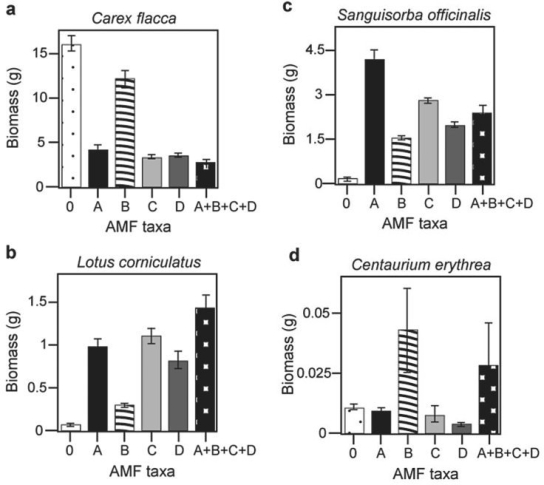Multiple Choice
Use the following information when answering the corresponding questions) .
There is much discussion in the media about protecting biodiversity, but does it really matter? Canadian and Swiss researcher to know if the diversity of arbuscular mycorrhizal fungi AMF) was important to the productivity of grasslands M.G.A. van d Heijden, J. N. Klironomos, M. Ursic, P. Moutoglis, R. Streitwolf- Engel, T. Boler, A. Wiemken, and I. R. Sanders. 1998. Mycorrh fungal diversity determines plant biodiversity, ecosystem variability and productivity. Nature 396:69- 72) . Specifically, they wanted to know if it mattered which specific AMF species were present, or just that some type of AMF was present. They grew various plants in combination with one of four AMF species, no AMF, or all four AMF species together; and they measured plant growth under each set of conditions. All plant species were grown in each plot, so they always competed
with each other with the only difference being which AMF species were present. Use the graphs in Figure 31.4 to answer the questions that follow. Note that the x- axis labels indicate the number and identity of AMF species bar 0 = no fungi; bars
A- D = individual AMF species; bar A+B+C+D = all AMF species together) . The y- axis indicates the amount grams) of plant biomass for the species shown in italics above each graph.
 Figure 29.4
Figure 29.4
-Based on the van der Heijden et al. 1998) graphs in Figure 29.4, which of the following is the best description of the data supporting the idea that a plant species did not form mycorrhizae with a fungus?
A) Its biomass is greatest when all AMF are present.
B) Its biomass is greatest when no AMF are present.
C) Its biomass is greatest when AM fungus C is present.
D) Its biomass is greatest when AM fungus A is present.
E) Its biomass is greatest when AM fungus B is present.
Correct Answer:

Verified
Correct Answer:
Verified
Q30: <img src="https://d2lvgg3v3hfg70.cloudfront.net/TB6548/.jpg" alt=" Figure 29.3 -Referring
Q31: If seedlings in the shade commonly do
Q32: Use the following information when answering the
Q33: Use the following information when answering the
Q34: This symbiotic association grows on rocks, where
Q35: Fungi are most closely related to which
Q36: Most coal was formed during the Carboniferous
Q37: Basidiomycetes are the only fungal group capable
Q38: Figure 29.1<br><img src="https://d2lvgg3v3hfg70.cloudfront.net/TB6548/.jpg" alt="Figure 29.1
Q40: Some fungal species can kill herbivores while